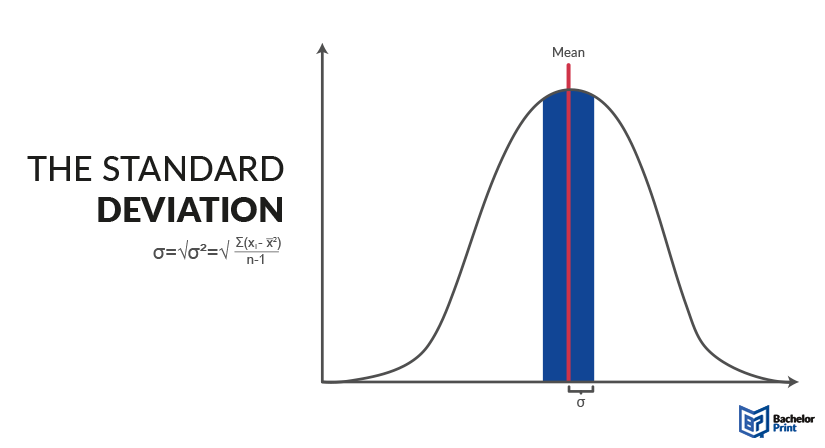
Statistics is a field of various numbers and values to calculate and interpret. Keeping track of every formula can be quite challenging at times, but every one of them still has their purpose in research. One of these values is the standard deviation, a measurement of deviation from the mean in a set of data. Typically, it is calculated by extracting the square root from the variance. The following article will cover everything you need to know about this topic.
Definition: Standard deviation
The standard deviation σ (Greek sigma) is calculated by extracting the square root of the variance, describing the average deviation from the mean in a dataset. It is used to determine how reliable the findings of a study are. A wide spread, meaning a high standard deviation, means that you have a lot of variability in your data. In that case, further research might be advised to confirm if the population deviation is broad spread or if there was research bias involved in your sample.

Calculation
To calculate the standard deviation, you simply extract the square root from the variance.
If you do not know the variance yet, you may use the following formula, which includes it directly.
| n | Number of values in the sample |
| Individual values in the population | |
| Mean | |
| σ | Standard deviation |
Step 1: Calculate the mean
At first, you need to calculate the mean by adding up all the values of the set before dividing them by the number of values.
Step 2: Subtract the mean from every value, then square
Next, you will have to subtract that mean from each value in the set before multiplying the result with itself.
Step 3: Sum up the squares
In this step, you simply add all the formerly calculated squares.
Step 4: Divide by the number of values
The result is thereafter divided by the absolute number of values.
Step 5: Square root
What was calculated before was the variance. As a last step, you extract the square root of the result to gain the standard deviation.
Interpretation
Interpreting the standard deviation can be simple or tricky, depending on what your research intention is. In numerous instances, the mere value of the standard deviation already gives a lot of insight on whether it is in the area of expectation or not. However, there may be times where interpreting it can seem difficult. Here you can find three ways to interpret the standard deviation more distinctly.
The empirical rule, also called the 68-95-99.7 rule, is used to interpret whether the outcome of the study is considered reliable in the setting of a normal distribution. Therefore, you can calculate if 68% of your values are one standard deviation around your mean, 95% should lie two standard deviations around and 99.7% three standard deviations around the mean.
68%:
95%:
99.7%:
The z-score, or also called standard score, is a way to normalize the data to resemble a standard normal distribution around the mean of 0 and a standard deviation of 1. Thereafter, you can look at each individual z-score and determine, whether the value is an outlier or not.
|z| < 1 → Typical
1 < |z| < 2 → Unusual
|z| > 2 → Extreme
The coefficient of variation (CV) is a simple measure that is calculated by dividing the standard deviation by the mean. It allows you to compare two or more datasets with the same unit measurement and how they vary. The CV norms different means and standard deviation to one comparable value. The µ in the following formula stands for the mean and can be replaced by just the same.
Standard error and standard normal distribution
There are quite a few standardized values in statistics, which can easily be confused due to their name. The standard deviation is, as already explained, the square root of the variance, describing the average deviation of single values from the mean. The standard error, on the other hand, estimates the deviation of countless sample means from the population mean.
Lastly, the standard normal distribution is a distribution of data symmetrically around its mean, which is 0. This must not be confused with a normal distribution in general, which is just symmetrical around the mean without a predefined mean value.
Mean absolute deviation (MAD)
Standard deviation is only one way of measuring variability. You can also use the mean absolute deviation or MAD. This method uses the original units of the data, so interpretation will be easy. Calculating MAD is also very easy. You just need to follow these steps:
- Calculate the sample average
- Find the absolute deviation of each data point from the mean. You should ignore any negative signs.
- Find the average of all absolute deviations
While MAD has some benefits, the standard deviation is still the most commonly used measure of variability. One of its advantages is that it weights unevenly spread out samples more as compared to evenly spread out samples. That means you will be able to tell that the data is more unevenly spread out. Standard deviation also gives you a more precise measure of variability. It is also worth noting that standard deviation is more sensitive to outliers.
Printing Your Thesis With BachelorPrint
- High-quality bindings with customizable embossing
- 3D live preview to check your work before ordering
- Free express delivery
Configure your binding now!
FAQs
Standard deviation is the average distance of values from the mean, being an indicator of the amount of variability in a dataset.
Low standard deviation means that the data points are clustered around the mean and the variability is low. Usually, low variability is something a researcher wants to achieve because it means that his treatment has the same effect on most of their participants.
Yes, a high standard deviation shows that the data is less reliable as it is widely spread. Furthermore, it indicates that the treatment the researcher used on the sample might not have any effect since every value is different. In measurements, it can also mean that there was an error in the sampling process or data collection.
Variance is the degree of spread in a dataset. If there is more spread in the dataset, the variance will be large in relation to the mean. The standard deviation is the square root of the variance and more frequently used as the value is easier to grasp for the mind.
